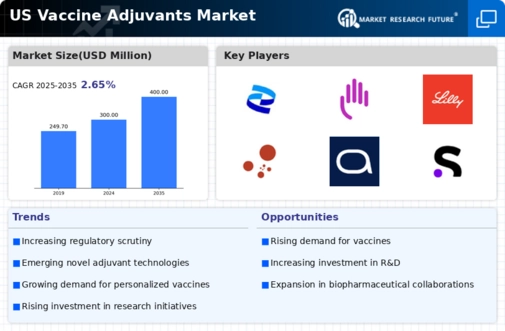Government Initiatives and Funding
Government initiatives aimed at bolstering vaccine research and development are playing a critical role in the vaccine adjuvants market. Increased funding for vaccine-related projects, particularly in response to emerging health threats, has led to a heightened focus on adjuvant research. The US government has allocated substantial resources to support the development of innovative adjuvants, which is expected to enhance the overall efficacy of vaccines. This financial backing not only stimulates research but also encourages collaboration between public and private sectors, thereby fostering a conducive environment for growth in the vaccine adjuvants market.
Growing Awareness of Vaccine Benefits
The growing awareness of the benefits of vaccination is significantly impacting the vaccine adjuvants market. As public health campaigns emphasize the importance of immunization, there is an increasing acceptance of vaccines among the population. This heightened awareness is likely to drive demand for more effective vaccine formulations, which often incorporate adjuvants to boost immune responses. The vaccine adjuvants market is expected to benefit from this trend, as healthcare providers seek to enhance vaccine effectiveness to meet the rising expectations of the public. Consequently, the market is poised for growth as more individuals opt for vaccinations.
Rising Demand for Preventive Healthcare
The vaccine adjuvants market is experiencing a notable surge in demand driven by an increasing emphasis on preventive healthcare measures. As healthcare systems in the US prioritize vaccination programs to mitigate disease outbreaks, the role of adjuvants in enhancing vaccine efficacy becomes paramount. This trend is reflected in the projected growth of the vaccine adjuvants market, which is expected to reach approximately $1.5 billion by 2027. The integration of adjuvants not only improves immune responses but also reduces the required dosage of antigens, thereby optimizing resource utilization. Consequently, healthcare providers are more inclined to adopt adjuvants in vaccine formulations, further propelling market growth.
Emerging Infectious Diseases and Biodefense
The emergence of infectious diseases and the need for biodefense strategies are critical drivers of the vaccine adjuvants market. As new pathogens continue to pose threats to public health, there is an urgent need for effective vaccines that can be rapidly developed and deployed. Adjuvants play a vital role in accelerating immune responses, making them essential in the fight against emerging diseases. the vaccine adjuvants market will see increased investment and research focus as governments and organizations prioritize biodefense initiatives. This trend underscores the importance of adjuvants in developing vaccines that can respond swiftly to public health emergencies.
Technological Innovations in Vaccine Development
Technological advancements in vaccine development are significantly influencing the vaccine adjuvants market. Innovations such as nanoparticle-based adjuvants and novel delivery systems are enhancing the effectiveness of vaccines. These technologies allow for targeted immune responses, which are crucial in developing vaccines for complex diseases. The market is projected to grow at a CAGR of around 8% from 2025 to 2030, indicating a robust interest in integrating advanced adjuvant technologies. As researchers continue to explore new methodologies, the vaccine adjuvants market is likely to expand, driven by the need for more effective and efficient vaccine solutions.




















Leave a Comment